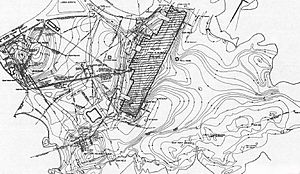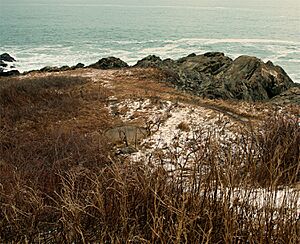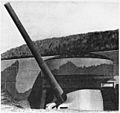East Point Military Reservation facts for kids
Quick facts for kids East Point Military Reservation |
|
|---|---|
| Part of Harbor Defenses of Boston | |
| Nahant, Massachusetts | |
|
Location in Massachusetts
|
|
| Coordinates | 42°25′11.98″N 70°54′35.85″W / 42.4199944°N 70.9099583°W |
| Type | Coastal Defense |
| Site information | |
| Owner | Massachusetts |
| Controlled by | United States Army |
| Site history | |
| Built | 1917 |
| Built by | United States Army |
| In use | 1917–62 |
| Battles/wars | World War I World War II Cold War |
| Garrison information | |
| Garrison | Nahant, Massachusetts |
The East Point Military Reservation was an important military base in Nahant, Massachusetts. It was built to defend the coast of the United States during World War I and World War II. Later, from 1955 to 1962, it became a launch site for Nike missiles. Today, most of this historic site is used by the Marine Science Center of Northeastern University.
Contents
History of East Point Fort
The United States Army bought the land for the East Point Military Reservation in 1917. This land was purchased from the Lodge family. At first, the site only had a searchlight and a place for soldiers to watch the coast. There was a plan to name it Fort Henry Cabot Lodge after a famous senator, but this never happened.
What East Point Looks Like Today
If you visit the site today, you can still see parts of its military past. There are old towers, the foundations (bottom parts) of former buildings, and strong bunkers. These bunkers once held big guns and ammunition.
East Point's Big Guns (Batteries)
The East Point Batteries were located in Nahant, Massachusetts. They were a key part of the Harbor Defenses of Boston during World War II. A "battery" is a group of large guns working together. Three main gun batteries were built here:
- Battery Murphy had two very large 16-inch guns.
- Battery 206 had two 6-inch guns.
- A temporary battery had two 155 mm artillery guns.
Along with these guns, there were three special towers called fire control towers. These towers helped aim the guns. Two were on Swallow Cave Road, and one was on Nahant Road. There was also a large underground room called a plotting room. This room helped direct the fire of Battery Murphy's huge guns.
Other towers were located further north in Marblehead and Manchester. The Navy also had special magnetic cables in the water nearby. These cables helped detect enemy ships, especially U-boats (submarines), trying to get close to Boston Harbor. This system was called "indicator loop" Station 1D.
All these important defense structures were located at East Point. This is at the very end of the Nahant tombolo (a narrow strip of land connecting an island to the mainland). After 1943, the guns at East Point, along with two 12-inch guns at Fort Ruckman, made Nahant the strongest part of Boston's coastal defenses.
The Different Types of Guns
Battery Murphy was one of many 16-inch gun sites built across the U.S. before and during World War II. Building this battery started in January 1942 and finished almost two years later in December 1943. The guns were powerful 16-inch Navy MkIIMI guns. They were placed on special stands called M4 barbette carriages. These guns could shoot shells as far as 45,150 yards (about 25 miles)! The guns were protected inside strong concrete shelters called casemates. These casemates were part of a larger bunker that also held ammunition and equipment for aiming the guns.
Battery 206 had 6-inch guns. These guns were designed to work with the larger 16-inch batteries during World War II. This battery was built at the same time as Battery Murphy, from 1942 to 1943. It had two 6-inch M1903 guns on long-range carriages with shields. These guns could hit targets up to 27,100 yards (about 15 miles) away. A large bunker between the guns stored ammunition and aiming equipment.
The battery of two 155mm guns used 155 mm M1918 guns. These guns could be moved (towed) and were placed on special concrete pads called "Panama mounts." These pads were 10 feet wide and had circular steel rails. The rails helped the guns turn easily.
This 155mm battery was a quick solution. It was set up between March and May 1942. It provided an emergency defense against enemy ships and submarines while the bigger gun batteries were still being built. From the very end of East Point, these guns could protect all of Boston Harbor. They could even reach as far south as Hingham, Massachusetts.
These guns could fire quickly. They were placed about 250 feet apart. A small wooden building was built between them for the Battery Commander. This building had tools to help find the distance and direction of enemy ships. This 155mm gun battery is thought to be the only one of its kind in Boston's harbor defenses. The surviving platform of Gun 1 is quite rare in New England.
How Fire Control Structures Worked
East Point had many fire control towers. These towers were crucial for the directing and correcting the aim of the guns. They helped soldiers figure out exactly where to shoot to hit enemy ships.
East Point After the Wars
In 1948, the big guns were removed, and East Point was no longer a coastal defense site. From 1952 to 1956, it was used for a battery of four 90 mm anti-aircraft guns. These guns were designed to shoot down enemy planes. Later, from 1955 to 1962, the site became a Nike missile base, known as site B-17L or B-17C. In 1967, Northeastern University bought the property.
Images for kids
-
A 6-inch gun at Fort Columbia State Park, Washington state, like those at Battery 206.










